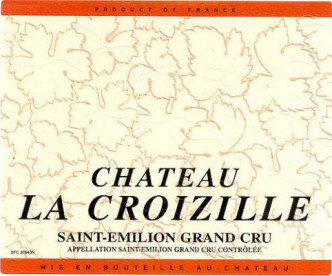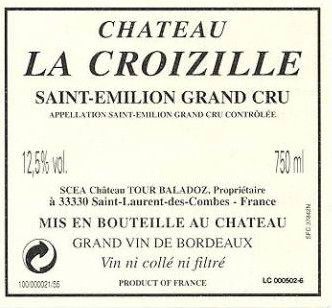 In 1996, the De Schepper family, who already owned Château Tour Baladoz, purchased the neighbouring estate, Château La Croizille (5 hectares) in Saint-Laurent-des-Combes. At first sight, this relatively little-known estate was not especially impressive. However, two years later, the new owners decided to make it into an extraordinary vineyard. Why?
In 1996, the De Schepper family, who already owned Château Tour Baladoz, purchased the neighbouring estate, Château La Croizille (5 hectares) in Saint-Laurent-des-Combes. At first sight, this relatively little-known estate was not especially impressive. However, two years later, the new owners decided to make it into an extraordinary vineyard. Why?
Above all, out of respect!
First of all, out of respect for nature. It must be said that La Croizille’s terroir – a limestone and molasse outcrop on the Saint-Emilion plateau – is particularly adequate to produce great wine. The south-facing vineyards provide outstanding sun exposure that allows perfect ripening, and the vineyard is planted with a well-adapted blend of premium grape varieties.
Making up 70% of this blend, Merlot harmoniously completes the amazing range of aromas and flavours provided by Cabernet Sauvignon (30%). Merlot is fairly easy to grow. This delicate variety does extremely well in the Libourne region.
Château La Croizille’s superb terroir is a little gem. Furthermore, the estate borders on such famous estates as Troplong Mondot, La Mondotte, and Tertre Roteboeuf.
 The “Grand Vin de Château La Croizille” is produced on a 1.5 hectare plot of 30 year-old vines with outstanding sun exposure.
The “Grand Vin de Château La Croizille” is produced on a 1.5 hectare plot of 30 year-old vines with outstanding sun exposure.
Secondly, out of respect for our ancestors. The father, Emile, originally came from Belgium. Thanks to many years of hard work and major investments, Emile and his son Firmin made of Château Tour Baladoz what it is today, i.e. one of the finest Grands Crus in Saint-Emilion. Of course it was only natural then that Emile’s younger son Jacques, wanted to confirm 50 years of family presence in Saint-Emilion by turning Château La Croizille into an exceptional wine. After all, tradition remains very important in the world of wine…
And also to accept the challenge!
A challenge for the young. The young team at Château La Croizille wants to prove that they too can combine nature’s gifts and intelligent winemaking to create something truly special. They are led by Jean-Michel Garcion, Jacques De Schepper’s right hand who has considerable winemaking experience in France and abroad. He is perfectly qualified to accept the challenge and very motivated to do everything necessary to establish this wine’s reputation, focusing on every factor, down to the smallest detail.
The vines are being handled with great care throughout the whole growing season. They are closely pruned, grass is left to grow between the vine rows, and the leaves are thinned on the eastern side in June and the western side in September. Furthermore, green harvesting is done so that only 4-5 bunches remain on each vine.
Careful sorting takes place at vintage time so that only perfectly ripe, healthy grapes are brought to the vat room. That same consideration is applied during the fermentation to make the most of the grapes’ natural potential, and the wine is put in barrels fairly early on. Château La Croizille is aged in 100% new oak for about 18 months. During this period, the wine is tasted and re-tasted to find the exact stage at which the desired structure from oak ageing has been reached.
Château La Croizille can thus be said to be the result of a mysterious interaction between genetics, terroir, and human expertise. Every bottle represents an ongoing and tireless search for aesthetic perfection.
